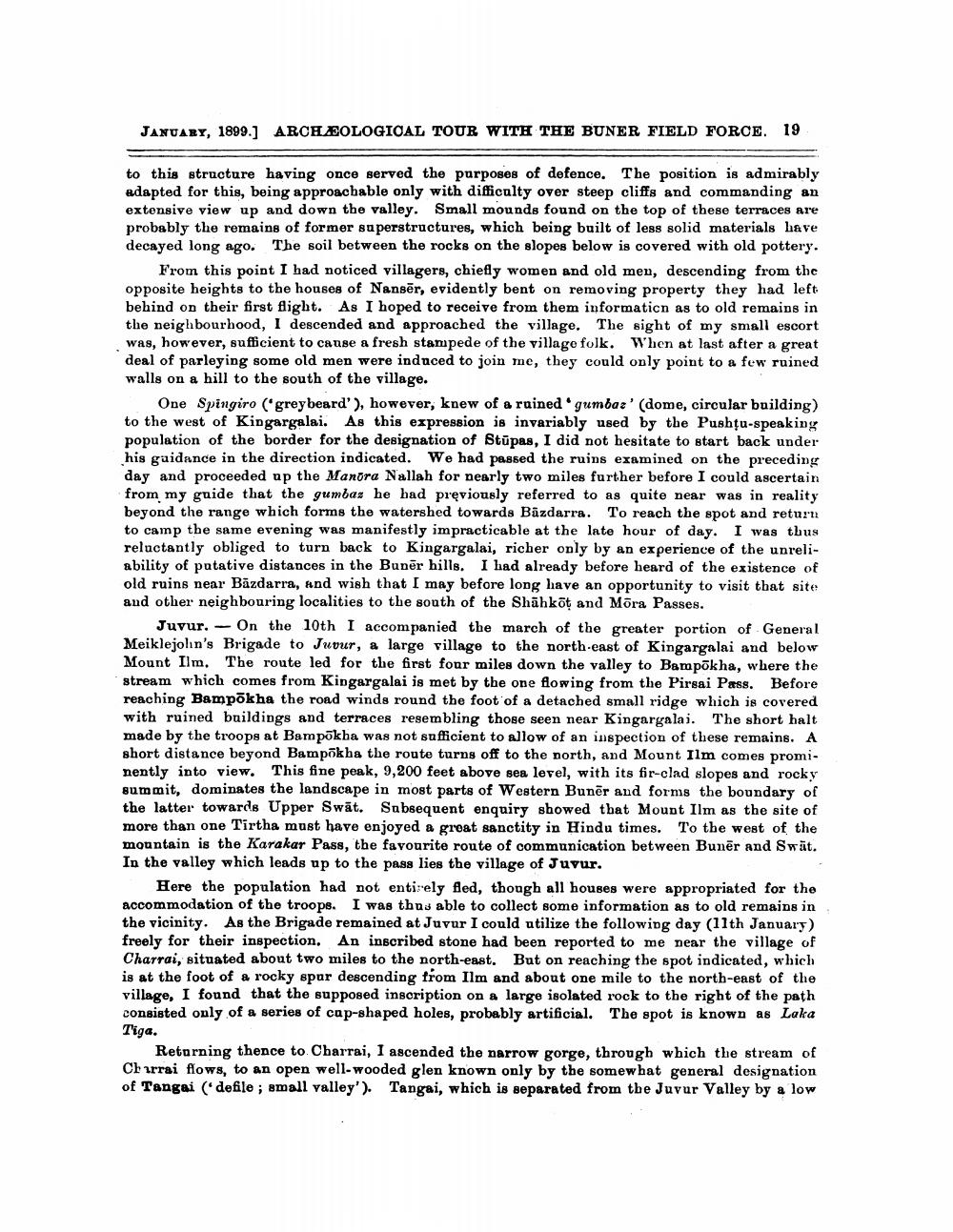________________
JANUARY, 1899.] ARCHEOLOGICAL TOUR WITH THE BUNER FIELD FORCE. 19
to this structure having once served the purposes of defence. The position is admirably adapted for this, being approachable only with difficulty over steep cliffs and commanding an extensive view up and down the valley. Small mounds found on the top of these terraces are probably the remains of former superstructures, which being built of less solid materials have decayed long ago. The soil between the rocks on the slopes below is covered with old pottery.
From this point I had noticed villagers, chiefly women and old men, descending from the opposite heights to the houses of Nanser, evidently bent on removing property they had left behind on their first flight. As I hoped to receive from them information as to old remains in the neighbourhood, I descended and approached the village. The sight of my small escort was, however, sufficient to cause a fresh stampede of the village folk. When at last after a great deal of parleying some old men were induced to join me, they could only point to a few ruined walls on a hill to the south of the village.
One Spingiro (greybeard'), however, knew of a ruined' gumbaz' (dome, circular building) to the west of Kingargalai. As this expression is invariably used by the Pushtu-speaking population of the border for the designation of Stūpas, I did not hesitate to start back under his guidance in the direction indicated. We had passed the ruins examined on the preceding day and proceeded up the Manora Nallah for nearly two miles further before I could ascertain from my guide that the gumbaz he had previously referred to as quite near was in reality beyond the range which forms the watershed towards Bāzdarra. To reach the spot and return to camp the same evening was manifestly impracticable at the late hour of day. I was thus reluctantly obliged to turn back to Kingargalai, richer only by an experience of the unreliability of putative distances in the Buner hills. I had already before heard of the existence of old ruins near Bazdarra, and wish that I may before long have an opportunity to visit that site and other neighbouring localities to the south of the Shahkot and Mōra Passes.
Juvur. On the 10th I accompanied the march of the greater portion of General Meiklejohn's Brigade to Juvur, a large village to the north-east of Kingargalai and below Mount Ilm. The route led for the first four miles down the valley to Bampōkha, where the stream which comes from Kingargalai is met by the one flowing from the Pirsai Pass. Before reaching Bampōkha the road winds round the foot of a detached small ridge which is covered with ruined buildings and terraces resembling those seen near Kingargalai. The short halt made by the troops at Bampōkha was not sufficient to allow of an inspection of these remains. A short distance beyond Bampōkha the route turns off to the north, and Mount Ilm comes prominently into view. This fine peak, 9,200 feet above sea level, with its fir-clad slopes and rocky summit, dominates the landscape in most parts of Western Buner and forms the boundary of the latter towards Upper Swat. Subsequent enquiry showed that Mount Ilm as the site of more than one Tirtha must have enjoyed a great sanctity in Hindu times. To the west of the mountain is the Karakar Pass, the favourite route of communication between Buner and Swat. In the valley which leads up to the pass lies the village of Juvur.
-
Here the population had not entirely fled, though all houses were appropriated for the accommodation of the troops. I was thus able to collect some information as to old remains in the vicinity. As the Brigade remained at Juvur I could utilize the following day (11th January) freely for their inspection. An inscribed stone had been reported to me near the village of Charrai, situated about two miles to the north-east. But on reaching the spot indicated, which is at the foot of a rocky spur descending from Ilm and about one mile to the north-east of the village, I found that the supposed inscription on a large isolated rock to the right of the path consisted only of a series of cap-shaped holes, probably artificial. The spot is known as Laka
Tiga.
Returning thence to Charrai, I ascended the narrow gorge, through which the stream of Chirrai flows, to an open well-wooded glen known only by the somewhat general designation of Tangai (defile; small valley'). Tangai, which is separated from the Juvur Valley by a low




